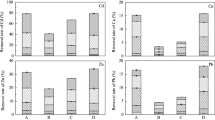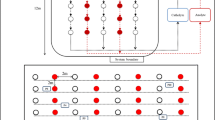Abstract
The use of a combination of electrokinetic remediation and phytoremediation to decontaminate two metal-polluted soils has been demonstrated in laboratory-scale reactors. One soil was heavily contaminated with copper, the other with cadmium and arsenic (2500 μg g-1 Cu; 300-400 μg g-1 Cd and 230 μg g-1 As, respectively). Test reactors with twoseparated chambers, each with a capacity of 5.25 kg soil, wereconstructed, then the respective chambers were filled with eithera mixture of the polluted soil and a control topsoil (75:25) ortopsoil alone. Reactors were sown with perennial ryegrass (Lolium perenne cv Elka) and a constant voltage of 30 V was applied continually across the soils in each reactor. Soil sampling took place at the start and the end of the test run, whilst plant foliage was sampled after approximately 3 weeks (both reactors) 6 weeks (Cd soil reactor only) and at the conclusion of each test run (98 days Cu soil, 80 days Cd soil). Soil and plant metal concentrations were measured, together withsoil pH. Results showed that in both soils there was a significant re-distribution of metals from anode to cathode in the test reactors, coupled with an enhancement of plant Cu uptakein the cathode region for the Cu soil. Patterns of plant Cd uptake were less clear cut and were not as clearly related to theredistribution of Cd measured in the soil. There was significant acidification of soil at the anode in each test reactor, but soilpH in other parts of the reactor changed little during the courseof the experiment. Plant growth was affected at the anode, but was not affected in other parts of the reactor. There was no visual evidence of metal toxicity in the ryegrass in either polluted soil. Some effects on soil fungi were apparent, with a stimulation of Fusarium infection of ryegrass in the cathode region of all reactors and the appearance of sporophoresof Coprinus in the same location. It is concluded that the combination of the two techniques represents a very promising approach to the decontamination of metal polluted soils that nowrequires validation in field conditions.
Similar content being viewed by others
References
Allen, S. E.: 1989, Chemical Analysis of Ecological Materials, 2nd ed., Blackwell Scientific Publications, Oxford.
Baker, A. J. M. and Brooks, R. R.: 1989, 'Terrestrial higher plants which hyperaccumulate metallic elements-A review of their distribution, ecology and phytochemistry', Biorecovery 1, 81-126.
Garbisu, C. and Alkorta, I.: 2001, 'Phytoextraction: A cost effective plant-based technology for the removal of metals from the environment', Bioresour. Technol. 77, 229-236.
Gartside, D. W. and McNeilly, T. S.: 1974, 'The potential for evolution of metal tolerance in plants. II. Copper tolerance in normal populations of different plant species', Heredity 32, 335-348
Kyeong-Hee, K., Soon-Oh, K. and Kyoung-Woong, K.: 2001, 'Electrokinetic Remediation for the Removal of Radionuclides in Soil', Proceedings of the Sixth International Conference on the Biogeochemistry of Trace Elements, Ontario, Canada, pp. 483.
Lepp, N. W.: 1998, 'Case Studies in the Field-Industrial Sites: The Prescot Copper Rod Plant', in J. Vangronsveld and S. D. Cunningham (eds), Metal-Contaminated Soils: In Situ Inactivation and Phytorestoration, Springer-Verlag, Berlin, pp. 217-218.
Lepp, N. W., Hartley, J. R., Toti, M. and Dickinson, N. M.: 1997, 'Patterns of soil copper contamination and temporal changes in vegetation in the vicinity of a copper rod rolling factory', Environ. Pollut. 1997, 363-369.
Maini, G., Sharman, A. K., Knowles, C. J., Sunderland, G. and Jackman, S. A.: 2000a, 'Electrokinetic remediation of metals and organics from historically contaminated soil', J. Chem. Technol. Biotechnol. 75, 657-664.
Maini, G., Sharman, A. K., Sunderland, G., Knowles, C. J. and Jackman, S. A.: 2000b, 'An integrated method incorporating sulfur-oxidizing bacteria and electrokinetics to enhance removal of copper from contaminated soil', Environ. Sci. Technol. 34, 1081-1087.
McGrath, S. P., Sidoli, C. M. D., Baker, A. J. M. and Reeves, R. D.: 1993, 'The Potential for the Use of Metal-accumulating Plants for the In Situ Decontamination of Metal-polluted Soils', in H. J. P. Eijackers and T. Hamers (eds), Integrated Soil and Sediment Research: A Basis for Proper Protection, Kluwer Academic Publishers, Dordrecht, pp. 673-676.
Mench, M., Vangronsveld, J., Lepp, N. W. and Edwards, R.: 1998, 'Physico-chemical Aspects and Efficiency of Trace Element Immobilization by Soil Amendments', in J. Vangronsveld and S. D. Cunningham (eds), Metal-Contaminated Soils: In Situ Inactivation and Phytorestoration, Springer-Verlag, Berlin, pp. 151-182.
Meyer, P. B., Williams, R. H. and Yount, K. R.: 1995, Contaminated Land: Reclamation, Redevelopment and Reuse in the United States and the European Union, University Press, Cambridge.
Ottosen, L. M., Hansen, H. K., Ribiero, A. B. and Villumsen, A.: 2001, 'Removal of Cu, Pb and Zn in an applied electric field in calcareous and non-calcareous soils', J. Hazard. Mater. 85, 291-299.
Pamukcu, S. and Wittle, J. K.: 1994, 'Electrokinetically Enhanced In Situ Soil Decontamination', in D. L. Wise and D. J. Trantolo, (eds), Remediation of Hazardous Waste Contaminated Soils, M. Dekker Inc., New York, pp. 245-298.
Smith, R. A. H. and Bradshaw, A. D.: 1972, 'Stabilization of toxic mine wastes by the use of tolerant plant populations', Transactions of the Institute of Mining and Mineral Metallurgy, Section A 81, 230-237.
Soon-Oh, K. and Kyoung-Woong, K.: 2001, 'Application of Electrokinetic Technique for the Remediation of Soils and Municipal Waste Water Sludges Contaminated with Heavy Metals', Proceedings of the Sixth International Conference on the Biogeochemistry of Trace Elements, Ontario, Canada, pp. 219.
Vangronsveld, J. and Cunningham, S. D.: 1998, Metal-Contaminated Soils: In Situ Inactivation and Phytorestoration, Springer-Verlag, Berlin.
Vangronsveld, J., Ruttens, A., Mench, M., Boisson, J., Lepp, N. W., Edwards, R., Penny, C. and Van der Lelie, D.: 2000, 'In Situ Inactivation and Phytoremediation of Metal-and Metalloid-contaminated Soils: Field Experiments', in D. L. Wise et al. (eds), Bioremediation of Contaminated Soils, Marcel Dekker Inc., New York, pp. 859-885.
York, C. A.: 1998, Turfgrass Diseases and Associated Disorders', Sports Turf Research Institute, Bingley, U.K.
Author information
Authors and Affiliations
Corresponding author
Rights and permissions
About this article
Cite this article
O'Connor, C.S., Lepp, N.W., Edwards, R. et al. The Combined Use of Electrokinetic Remediation and Phytoremediation to Decontaminate Metal-Polluted Soils: A Laboratory-Scale Feasibility Study. Environ Monit Assess 84, 141–158 (2003). https://doi.org/10.1023/A:1022851501118
Issue Date:
DOI: https://doi.org/10.1023/A:1022851501118




